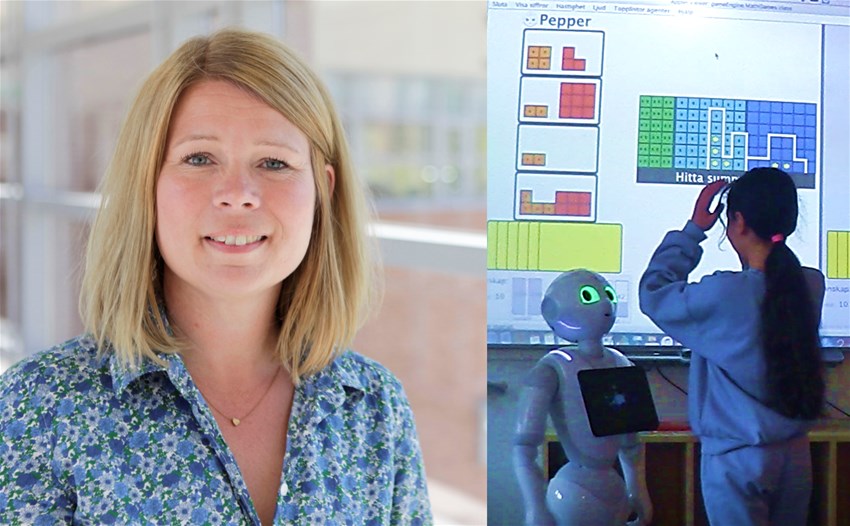What is it like teaching with social robots?
03 Apr 2023
Technological developments and digitalisation are increasingly shaping society and also the world of education. A new thesis from University West provides a description of how teaching with social robots can be done and how the role of the teacher is affected, making them more of a mentor who makes the interaction between student and robot work.

- I hope my research can help to enhance understanding of the role of the teacher when using a social robot in teaching, and that it will be useful for future school development and how the school is shaped, says Sara Ekström, who was recently awarded a doctorate in informatics specialising in Work Integrated Learning. Sara previously taught mathematics and physics at upper secondary level for 15 years.
Sara describes what a social robot is.
- A social robot senses the presence of people and you can talk to it and make eye contact with it. It can convey emotions by looking happy or sad, for instance. The one we used has movable joints that can simulate human-like body language.
Previous research shows that social learning robots can enhance student motivation and engagement, but also stimulate students’ reasoning and problem-solving skills. Social robots have been studied in various educational contexts and school subjects, but also in different roles, such as teacher, teaching assistant, learning companion or novice. When social robots are designed as learning companions, as in this case, this is based on the concept of learning-by-teaching, where the child learns by teaching the robot various skills and abilities.
Teacher behaviour studied
This thesis studies how the teacher acts in a learning activity in which a child is collaborating with a social learning robot. The child and the robot play a digital maths game together on an interactive board. The robot is designed to act as an inquisitive learning companion (tutee), while the child acts as a teacher (tutor). The study is mainly based on video observations of teachers’ actions as part of this learning activity, and a total of over 25 hours of recorded video has been analysed. The observations are complemented by interviews, workshops and surveys, giving more teachers an opportunity to reflect on teaching with social robots.
Teacher role affected
The use of social learning robots creates a complex teaching situation and affects the role, actions and responsibilities of the teacher in the classroom.
- Few studies highlight the role and actions of the teacher, and that was something that I wanted to try to describe. The results of this study show that using a social learning robot can create interesting and relevant learning situations, and teachers confirm that the robot fulfils an educational function, explains Sara.
The most prominent teacher role observed is that of an interaction mentor. In this role, the teacher assists with the verbal and non-verbal interaction between the child and the robot.
- It mostly involves helping the child to talk to the robot, explaining the robot’s questions and how the robot interprets the child’s answers. But it also involves explaining the robot’s behaviour to the child and ensuring that the child and the robot focus their attention on one another, says Sara.
Several challenges
The study also shows that the robot brings with it many challenges. For instance, a number of technical problems arise that require the teacher to act as a technical facilitator. The different ways in which the teacher relates to the robot present another challenge.
- Sometimes the teacher views the robot as a didactic tool, and sometimes as a social actor. This duality leads to conflicts in the teacher’s actions, as the two perspectives are not always compatible.
This involves considering which learning object should be the focus of the current activity, for instance, and what social norms are reasonable in a child-robot collaboration.
Requirement for new skills
The thesis also shows that the use of social learning robots places new demands on what adequate digital competence involves. Technical competence, which refers to computer security and programming skills, is one aspect of the concept of competence.
- The robot comes equipped with both cameras and microphones, and so a lot of information about the child is recorded and collected and it is necessary to know how to handle this data.”
Another aspect is critical competence, which includes various ethical dilemmas that arise if social robots are used in educational contexts.
- In a way, the child is “tricked” into believing that the robot is something it is not, that it has feelings and becomes a friend. It is necessary to know what to do when interaction turns into a relationship, for example. Is that desirable? And where does one draw the line?
A third aspect is practical competence, which involves being able to interact with social learning robots yourself, but also about being able to understand and use the robot’s two perspectives to achieve the objective of the teaching.
- I hope that my thesis will help to increase awareness of the opportunities and challenges involved in using social learning robots, and that schools can gain an insight into the new requirements for digital skills that will emerge when educational technologies exhibit social characteristics and behaviours.
To the thesis: Teaching with social robots
Contact: Sara Ekström, PhD in informatics specialising in Work Integrated Learning, University West, sara.ekstrom@hv.se


